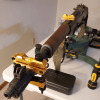Tower Squirrel
Member
- Joined
- Sep 19, 2022
- Messages
- 3
Good morning!
I have an M1 Garand and one of those Ultimak-brand after market rail mounts which replaces the top hand guard. I have a scout scope for it!
My question is this: using a Wheeler scope leveling kit (picture included for example), how do you find the "true top" of the Garand? It's a very round and organic-shaped gun! There's a couple flat-looking spots on the receiver, but they all measure "level" differently.

Is one of these spots the "best" to use with your first bubble level? How would a gunsmith install this rail so that it's super level over the bore?
It's probably easier with more modern guns since many of them have a nice flat top built in.
Thanks for your help!
I have an M1 Garand and one of those Ultimak-brand after market rail mounts which replaces the top hand guard. I have a scout scope for it!
My question is this: using a Wheeler scope leveling kit (picture included for example), how do you find the "true top" of the Garand? It's a very round and organic-shaped gun! There's a couple flat-looking spots on the receiver, but they all measure "level" differently.

Is one of these spots the "best" to use with your first bubble level? How would a gunsmith install this rail so that it's super level over the bore?
It's probably easier with more modern guns since many of them have a nice flat top built in.
Thanks for your help!


